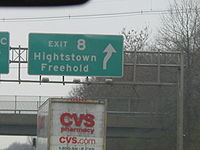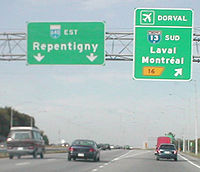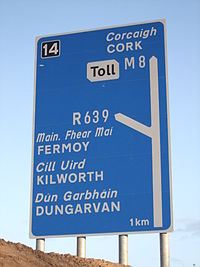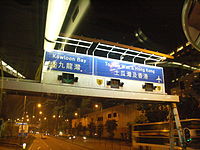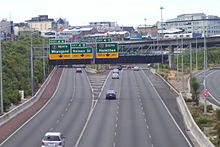- Exit number
-
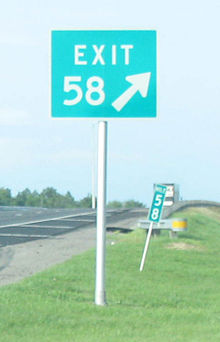 On a road with distance-based exit numbering, the exit number (shown here on a gore sign) matches a nearby mile or kilometer marker.
On a road with distance-based exit numbering, the exit number (shown here on a gore sign) matches a nearby mile or kilometer marker.
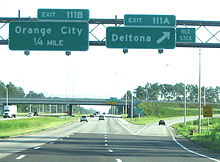 Exit numbers on Interstate 4 in Volusia County, Florida. In this case, mile-based exits 111A and 111B had been sequential exits 53CA and 53CB, as the 'OLD 53CA' tab shows.
Exit numbers on Interstate 4 in Volusia County, Florida. In this case, mile-based exits 111A and 111B had been sequential exits 53CA and 53CB, as the 'OLD 53CA' tab shows.
An exit number is a number assigned to a road junction, usually an exit from a freeway. It is usually marked on the same sign as the destinations of the exit, as well as a sign in the gore.
Exit numbers typically reset at political borders such as state lines.[1]
Some non-freeways use exit numbers. Typically these are rural roads built to expressway standards,[citation needed] and either only the actual exits are numbered, or the at-grade intersections are also numbered. An extreme case of this is in New York City, where the Grand Concourse and Linden Boulevard were given sequential numbers, one per intersection. A milder version of this has been recently used on the West Side Highway, also in New York, where only the major intersections are numbered (possibly to match the planned exits on the cancelled Westway freeway). Another case is the Nanaimo Parkway in Nanaimo, British Columbia carrying Highway 19, where all exits are numbered though all except one are at-grade intersections. Some other intersections on Highway 19 outside Nanaimo are also given numbers.
As a means of educating motorists, some state highway maps include a brief explanation of the exit numbering system on an inset. Iowa DOT maps from the 1980s and 1990s included a picture or drawing of a milepost and briefly described how Iowa had included milepost references near interchanges on the map.
Contents
Sequential numbers
The New Jersey Turnpike, with its unusual exit signage, displaying exit 8. This interchange was opened in 1951.
The first exit numbers were sequential.[2] This type of exit numbers usually begins with exit 1 at the beginning of the road; each subsequent exit is given the next number. In the case of cloverleaf interchanges, where two sets of ramps connect two roads, the separate exit ramps are often suffixed with a letter, such as 15A and 15B. Some older schemes assigned directional letters (15N for northbound, 15S for southbound) In France and Japan, decimals are used, as in 15.1 and 15.2.
When new exits are added to a road between two existing exits, the new exit is often given a number with a letter suffix, for example exit 15A may be assigned to a new exit between exit 15 and exit 16. On the New York State Thruway, an exit was added between 21 and 21A, leading to the sequence 21 - 21B - 21A - 22. In Florida, some new exits got the suffix C, so that if it had or acquired separate exits for the two directions they would be 15CA and 15CB rather than 15AA and 15AB, and also if the original exit with the same number got separate ramps per direction they would be (for example) 15A and 15B instead of having to renumber the new interchange.
Occasionally sequential exits are renumbered due to added exits. For instance, the Hutchinson River Parkway in New York was renumbered so that its northernmost exit, 27, became 30. However, the Merritt Parkway, which continued its exit numbers in Connecticut, was not renumbered, and the sequence now jumps from 30 down to 27 (the interchange on the state line had two exit 27s, and now has exits 30 and 27).
The Atlantic City-Brigantine Connector in Atlantic City, New Jersey approached the previous problem in a different way by using letters without numbers for its exits. The connector was appended to the eastern end of the Atlantic City Expressway, thus extending the highway from mile zero. Assigning the connector numbered exits would have required re-numbering all the exits on the entire expressway.
Eleven U.S. states currently[update] use sequential numbering schemes, although amendments to the Manual on Uniform Traffic Control Devices require them to transition to distance-based numbering.[3]
Distance-based numbers
As more highways were built, the limitations of sequential numbering became clear, and states began to experiment with distance-based (mile- or kilometre-based) exit numbers. The first mile-based system known was implemented on the Garden State Parkway in New Jersey in the late 1950s. Michigan also implemented mile-based junction numbers on Interstate 94 in the 1960s. In this system, the number of miles from the beginning of the highway to the exit is used as the exit number. If two exits end up with the same number, the numbers are sometimes slightly modified; this is often impossible and exits are given sequential or directional suffixes, just as with sequential numbers.
An exit can be numbered by where the exit in the direction of increased mileage leaves the freeway, or by where the road that the exit serves crosses the freeway (which is occasionally ambiguous). The US MUTCD recommends the latter. From this number, the integer exit number can be determined by rounding up, rounding down, or rounding to the nearest integer. Many jurisdictions prefer to avoid an exit 0. To this end, the numbers are either rounded up to get the exit number, or any exit that would get the number 0 is instead numbered 1. Examples of highways with an exit 0 are British Columbia Highway 1 on the B.C. mainland, Interstate 10 in El Paso, Texas along the New Mexico-Texas border, Interstate 70 in Wheeling, West Virginia along the West Virginia-Ohio border, Interstate 90 on the Montana side of the Idaho-Montana border, and Interstate 65 in two locations: at its terminus with Interstate 10 in Mobile, Alabama, and just north of the Ohio River in Jeffersonville, Indiana.
In areas that use the metric system, distance-based numbers are by kilometre rather than mile. A few highways, such as Delaware Route 1 and Interstate 19, have been renumbered from miles to kilometres, even in areas that typically use miles. I-19 has received funding for the distances to be changed back to miles.[4]
Distance-based numbers have several advantages. They match the mileposts along the road; it is thus easy to calculate how far one has to go. Additionally, most new exits don't need letter suffixes, as in a sequential system. Two other advantages are outlined in this guide.
Suffixes are required when the same mile of highway contains multiple exits; an extreme example is along several different highways in Kansas City, Missouri, where there are 23 exits in the four-mile long "Alphabet Loop", designated 2A through 2Y (the I and O suffixes are skipped because of their resemblance to 1 and 0 respectively). However, for calculation purposes, suffixed exits in a distance-based system can be approximated by using the number without a suffix.
On the other hand, there are some disadvantages to changing from a sequential system. Businesses and motorists have to adapt to the changes, and it costs money to replace the signs (as well as for temporary "old exit" tabs to ease the transition). Due to a kilometre being 0.621 miles, the probability of multiple exits within the same kilometre is less than the probability of multiple exits within the same mile.
Exit numbers by region
Australia
Australia uses distance-based numbering on a section of the M3/M1 Pacific Motorway south of Brisbane, and also on the M1/A1 Gateway Motorway/Bruce Highway. Sequential numbering has been implemented on the metropolitan section of the M1 (Monash Fwy, West Gate Fwy) through Melbourne. Exit numbering is being considered on other motorways across the country.
The Australian Manual of Uniform Traffic Control Devices (AS 1742) requires exit numbers to be green text on a white background, and for exits to be numbered sequentially rather than distance-based.
Europe
Sign at Junction 14 of the Republic of Ireland's M8. The design and positioning of the junction number on signs is similar to that in the United Kingdom.
Most European countries use sequential numbering schemes. Spain uses distance based numbering on its Autovias, but not on its Autopistas. Austria, Hungary, Slovakia and the Czech Republic use distance-based schemes. A number of European countries (including the Netherlands, Belgium and France) do not number motorway intersections, apparently because one cannot "exit" the motorway there[citation needed]. Countries like Germany and Switzerland have attributed numbers to their exit, but instead of the usual exit symbol, they are given a specific interchange symbol.
Italy only uses (sequential) numbering on the ring roads of a couple of cities, including the ring road of Rome (GRA) and Milan (Tangenziali). At one time, it referred to junctions on the Autostrada Del Sole by number, and published same on toll tickets; though these may not have been posted on signs.
Both the United Kingdom and Republic of Ireland use sequential numbering systems, with the junction number indicated by a white number in a black square in the corner of signs. In the United Kingdom they are frequently referenced in the media as the number with "J" on front of it, with for example Junction 1 being referred to as "J1". If a junction is newly constructed to between two existing junctions, it is normally allocated the number of the lower of the two junctions, with the letter "a" attached (and so on). For example, the junction to Heathrow Airport from the M4 is Junction 4a and the M25 interchange is Junction 4b.
In the Republic of Ireland, junction numbers have existed since the opening of the first section of the M50 motorway in 1990, however due to the short length of Irish motorways until the early 2000s they were normally ignored by the general public. They are beginning to come into popular usage now, and since 2005 have been given greater prominence on road signs. With the development of the inter-urban motorway network under the National Development Plan and Transport 21, the National Roads Authority has adopted a numbering scheme for the inter-urban roads that will see Junction 1 being designated as that road's junction with the M50 in most cases. This has meant renumbering of existing junctions on some motorways, most notably the M7 motorway. Non-motorway dual carriageways forming part of major inter-urban roads also have junction numbers, however only grade-separated interchanges are numbered.
Sweden initially did not use exit numbers. Instead, motorway junctions were named, with a separate sign prior to the exit displaying the name. Around 2005, Vägverket, the Swedish road agency, started to issue exit numbers, but only to longer continuous stretches of motorway. The exit numbers are incremental starting with the last exit number in Denmark. When motorways diverge, they inherit exit numbers from the original highway. Exit numbers are only on the information signs prior to the exit (not on the junction name signs), and none near or at the gore point. It is common to see exit numbers skipped when routes temporarily became regular roads through towns.
Canada
Of all the provinces in Canada, only two use sequential numbers: Nova Scotia, and Newfoundland and Labrador. The territories of Yukon, Nunavut, and Northwest Territories use no exit numbers, as there are no freeways or expressways in the territories. Prince Edward Island has no exit numbers either, since it has no freeways, and only one trumpet-style interchange. Nova Scotia also numbers level junctions on designated express highways.
New Brunswick, Quebec, Ontario, Alberta and British Columbia used kilometre-based exit numbers on most expressways in those provinces.
- Saskatchewan does not really use exit numbers, but on a section of Highway 11 from Regina to Lumsden, letters "A", "B", and "C" are used as "exit letters".
- Ontario has the oldest exit number system, having started posting exit numbers sequentially in the 1960s along Highway 401. Most short freeways do not have exit numbers, and until about 2000 (with Highways 11 and 69/400), incomplete freeways also did not have exit numbers. The words Exit and Sortie were dropped in Toronto to provide a descriptive bilingual exit numbering only on provincial freeways. Exits are denoted by arrows indicating exit ramps and lanes.
- Quebec has the second oldest system, and (with Ontario), the only junction numbering systems to use mile-based junction numbering before the Canadian metric conversion in the mid-1970s.
- Manitoba has the fewest posted exit numbers. The province started posting exit numbers on the Perimeter Highway in 2001.
- Alberta has a relatively new exit number system. The province started posting exit numbers on Highway 2 in 2004, and has since extended the system to Highway 1, Highway 16, Highway 201, and Highway 216.
Hong Kong
Exit numbers were introduced to major Hong Kong routes in 2004, in conjunction with the re-organization of the route numbers. A sequential numbering scheme is used.
Japan
The main expressway system uses sequential numbering; Metropolitan Expressway systems also use sequential junction numbering, usually appended with the expressway number expressed this way: 5-1; 5-2, etc. There are multiple toll expressways not operated by the major national syndicates or the Metropolitan Expressway Authorities that have no junction numbering scheme.
Malaysia
The syntax for highway exits in Malaysia is in the format Johor Bahru exit at the end of North-South Expressway is labelled Jalan Templer exit at the Federal Highway is labelled North-South Expressway are numbered as Cheras–Kajang Expressway, which is located between the older edit] New Zealand
New Zealand began introducing exit numbers in 2005. It uses a distance-based numbering system. The distance to the exit is measured from the origin of the highway. That is:
- State Highway 1 (Northern & Southern motorways) measured from the origin of SH1 at Cape Reinga
- State Highway 16 (Northwestern Motorway) measured from the origin at the Port
- State Highway 20 (Southwestern Motorway) measured from the origin at SH1
There is no exit zero. If there is an exit within 1.499 km of the origin, Exit 1 is used. Exit 2 would be between 1.500 and 2.499 km of the origin. Subsequent 'exit zones' are at 1 km intervals.
The multi-exit Central Motorway Junction in Auckland, New Zealand, showing overhead exit signs with added letter suffixes.
Letter suffixes are added at multi-exit interchanges, or where two or more exits exist within the same exit zone. For example, State Highway 1 (Southern Motorway) has an Exit 429A (Symonds St), Exit 429B (Wellesley St) and Exit 429C (Port).
Instead of replacing existing ramp and link signs, the exit numbers were added as supplementary information. Thus drivers can navigate either by exit number or name.
Exit numbers are only used for exits that may be used by all vehicle types. Bus- or emergency vehicle-only exits would not be numbered.
Exit signage and text is identical in appearance to American freeway signs.
The Philippines
Metric distance based numbers are used on the tollways radiating from Manila. Supplemental "A" and "B" designations are appended to signage at the ends of slip roads. Freeway signage, exit tabs, and kilometer-posts are nearly identical in appearance to American freeway signage.
South Africa
Uses distance based numbering (in kilometers) on main motorways. Letter suffixes are added at multi-exit interchanges, an example being the Buccleuch interchange in Johannesburg. Exit numbers are reset on the pre-1995 provincial borders, thus exit numbering can change in the middle of a post-1995 province. One exception to the usual distance based numbering is the southern portion of the M4 in Durban, which uses sequential numbering.
Taiwan
Taiwan uses distance-based exit numbers in kilometers. If two exits are located within the same kilometer mark, the Roman letters are appended to differentiate the exits. Taiwan did experiment with sequential exit numbers with National Freeway No. 1 for a couple of years, but abandoned the experiment in 2004.
Prior to 2006, Taiwan exit signs were generally near replicas of their US counterparts. However, the exit signs now not only indicate the distance number, but they also display the Chinese code-name for the interchange.
United States
The use of sequential or distance-based exit numbering currently varies by state, with 43 states using distance-based exit numbering and seven states using sequential numbering. The latest edition of the Manual on Uniform Traffic Control Devices (MUTCD), issued by the Federal Highway Administration on December 16, 2009, eliminates the option for states to use sequential exit numbering, and requires the seven states that presently number their exits sequentially to convert to distance-based numbering by January 2020. Citing the cost for conversion and the potential inconvenience to motorists and businesses, most of the states that still use sequential-based exit numbering are applying for waivers from the Federal Highway Administration (FHWA) that would allow them to retain their respective exit numbering systems beyond the 2020 mandatory conversion date.
References
- ^ FHWA - MUTCD - 2003 Edition Revision 1 Chapter 2E
- ^ Steve Krause: Blog: Highway Exit Numbers: When Simple Was Too Simple
- ^ Chapter 2E-MUCTD 2009 Edition Section 2E.31 "The consecutive exit numbering method shall not be used."
- ^ Holley, Denise (March 17, 2009). "New signs on Interstate 19 courtesy of recovery funds". Nogales International. http://www.nogalesinternational.com/articles/2009/03/17/news/doc49bfc57826497437558648.txt. Retrieved 2009-12-29.
Categories:
Wikimedia Foundation. 2010.

